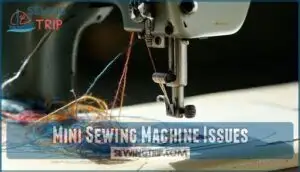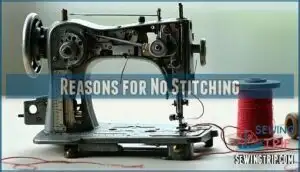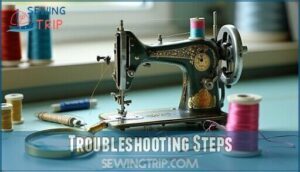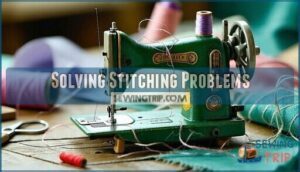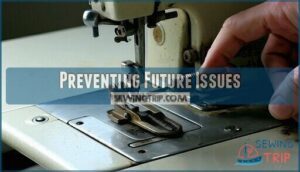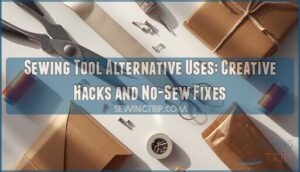This site is supported by our readers. We may earn a commission, at no cost to you, if you purchase through links.
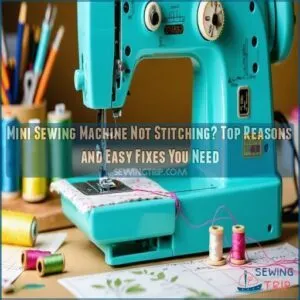
First, check the needle, thread, and bobbin to verify they’re properly inserted and not tangled. Also, inspect the machine’s power source and fabric type.
If issues persist, try cleaning the machine, adjusting thread tension, or consulting your manual. By troubleshooting these common problems, you’ll be sewing like a pro in no time.
Now, let’s take a closer look at the top reasons and solutions for your mini sewing machine not stitching.
Table Of Contents
Key Takeaways
- You’ll fix your mini sewing machine’s stitching issues by checking the needle, thread, and bobbin to ensure they’re properly inserted and not tangled, and by inspecting the machine’s power source and fabric type.
- To resolve common stitching problems like skipped stitches or uneven stitches, you’ll need to adjust thread tension, clean the machine, and check for needle breaks or misaligned components, which can be done by following a troubleshooting guide.
- You can prevent future issues with your mini sewing machine by performing routine inspections and repairs, storing it properly, and avoiding heavy fabrics, which will help keep it running smoothly and prevent stitching problems.
- By mastering the key areas to check, such as bobbins insertion, needle positioning, and thread tension, you’ll be able to quickly identify and fix issues with your mini sewing machine, making you a pro at troubleshooting and getting back to sewing in no time.
Mini Sewing Machine Issues
You might notice your mini sewing machine struggling to stitch properly or skipping stitches altogether.
Mini sewing machines can be finicky, skipping stitches or struggling to sew properly sometimes
These issues often stem from setup errors, mechanical faults, or limitations in the machine’s design.
Common Stitching Problems
Skipped stitches, uneven stitches, thread snapping, or fabric bunching are common stitching issues with a mini sewing machine.
These problems often happen because of incorrect thread tension, poorly inserted bobbins, or dull needles.
Sometimes, needle breaks and misaligned components worsen sewing machine problems.
Regular troubleshooting, like checking thread tension and keeping parts clean, can fix many issues quickly.
Machine Malfunction and Breakage
Sometimes, mini sewing machines disappoint due to their design limitations.
Frequent stitching issues often emerge from component failure or durability concerns.
Here’s what could be going wrong:
- Repair Frequency: Overuse can strain internal parts, leading to breakdowns.
- Expected Lifespan: These machines aren’t built for the long haul.
- Sewing Machine Troubleshooting: Regular maintenance reduces machine malfunction risks.
Many issues such as thread bunching problems can be easily avoided with proper technique.
Reasons for No Stitching
When your mini sewing machine isn’t stitching, the problem usually lies in its setup or components.
Common culprits include incorrect bobbins insertion, needle positioning, thread tension, or feed dog issues.
Improper Bobbin Insertion
Improper bobbin insertion is a common cause of stitching problems in mini sewing machines. Verify the bobbin direction matches the manual, avoiding reverse threading.
Check for lint buildup, which may cause thread snagging. Using the wrong bobbin size or misaligned bobbin case can lead to issues.
Here’s a quick guide:
| Issue | Cause | Solution | Result |
|---|---|---|---|
| Bobbin direction | Incorrect setup | Reinsert per manual | Smooth stitching |
| Lint buildup | Dirty bobbin area | Clean thoroughly | Prevents thread jams |
| Thread snagging | Loose thread path | Rethread properly | Consistent tension |
| Bobbin case alignment | Misaligned case | Realign carefully | Resolves skipped stitches |
The solutions provided aim to resolve common issues such as smooth stitching, thread jams, and skipped stitches by following the guide and ensuring proper bobbin insertion and maintenance.
Incorrect Needle Positioning
If your mini sewing machine isn’t stitching, check needle positioning first.
Needle installation errors are common—ensure the flat side faces the screw.
A bent needle can also jam the machine or worsen tension problems.
Needle size matters too; consult your manual for fabric-specific recommendations.
Misalignment with the needle plate can disrupt threading the needle, causing stitching issues.
Insufficient Thread Tension
Thread tension is everything in a mini sewing machine.
Loose tension can cause skipped stitches, while tight tension might snap threads.
Adjust the tension dial gradually and check thread quality—it matters.
Bobbin tension also plays a role; make certain it isn’t too tight for your fabric weight.
Testing on scrap fabric helps spot tension problems before starting your project, ensuring that thread quality is not an issue.
Feed Dog Malfunction
If fabric isn’t moving or you notice uneven stitch length, feed dog issues could be at play.
Check the feed dog height; it must lift fabric properly. Worn dog teeth or poor alignment also cause feeding problems.
Clean around the feed dogs and make certain nothing’s stuck. For stubborn cases, consider a sewing machine repair or alignment fix.
Troubleshooting Steps
Fixing a mini sewing machine that’s not stitching might seem tricky, but with the right steps, it’s manageable.
By carefully checking key areas like the bobbins, needle, and feed dogs, you can often resolve the problem quickly, which involves understanding complete concepts.
Cleaning The Bobbin Area
A dirty bobbin area can cause stitching headaches. Grab a soft brush, clear any lint or thread buildup, and verify the bobbin is in right. A clean sewing machine runs smoother and avoids bobbins issues.
Regular maintenance helps prevent tension spring problems.
- Use a toothbrush for lint removal.
- Check for loose threads.
- Use compressed air cautiously.
- Avoid over-oiling mechanisms.
- Clean regularly as a preventative measure to ensure a smooth operation and prevent future stitching headaches.
Checking Thread Tension and Needle Position
Tension balance and needle types play key roles in stitch quality.
Insert the needle with the flat side facing the screw, and double-check the threading path.
Needle problems or incorrect tension settings often disrupt stitching.
A precise tension measurement guarantees superior stitch formation.
Use this table for guidance:
| Issue | Cause | Fix | Notes |
|---|---|---|---|
| Loose stitches | Low tension | Tighten top thread tension | Use scrap fabric first |
| Missing stitches | Wrong needle insertion | Adjust needle position | Flat side faces screw |
| Snapped threads | Incorrect threading path | Rethread the sewing machine | Keep path clear |
| Uneven stitch quality | Fabric incompatibility | Match needle and thread to fabric | Check manual |
Inspecting Feed Dogs and Machine Components
Feed dogs play a key role in your mini sewing machine feeding fabric correctly. Verify their alignment and clean lint from between the teeth.
Inspect moving parts during sewing machine maintenance for smooth operation. Check for:
- Feed dog alignment.
- Needle plate damage.
- Belt tension and motor function.
- Component lubrication.
Don’t skip regular sewing machine parts inspections, as this ensures smooth operation and proper maintenance.
Adjusting Hook Timing and Bobbin Case
You adjust the hook timing and bobbin case on your mini sewing machine by loosening the needle bar and sliding it to align timing marks.
Using timing adjustment tools for precise DIY hook repair is an option, or seeking professional assistance for complex bobbin issues and tension-related sewing machine fixes can be considered for more complicated problems, especially when professional help is needed for accurate repair.
Solving Stitching Problems
You’re having trouble with your mini sewing machine not stitching, and it’s frustrating.
To solve this problem, you’ll need to identify the cause and apply the right fix, which can be as simple as adjusting the thread tension or using the correct needle size.
Identify the cause and apply the right fix to solve stitching problems easily
Using Correct Needle Size and Thread Type
When sewing with your mini sewing machine, you need to take into account Needle-Fabric Compatibility.
Thread Weight Matters for Stitch Quality Impact. Choose the right needle and thread for your fabric type to avoid breaks and guarantee good stitch quality on your mini sewing machine.
Using the correct needle sizes is vital for superior sewing.
Adjusting Tension Settings and Machine Speed
You’ll master your mini sewing machine by balancing tension and speed.
Adjusting tension settings and machine speed improves stitch quality, especially with different fabric types and thread weights.
Ensuring a perfect fix for your mini sewing machine.
Implementing Proper Fabric Handling Techniques
You can achieve better results with your mini sewing machine by using fabric stabilization and layer alignment techniques.
Guiding fabric gently and avoiding tension helps. Online resources offer tips on sewing machine solutions for fabric not feeding properly, reducing common issues with your mini sewing machine and fabric.
Using starch or stabilizers can substantially improve fabric handling techniques, which is a key aspect of achieving success with your mini sewing machine, particularly in terms of fabric handling and overall sewing machine performance.
Regular Machine Maintenance and Cleaning
Fabric handling’s key, but don’t forget your machine! Regular maintenance is essential. It keeps your mini sewing machine humming.
Neglecting it leads to problems. You don’t want that. So, what should you do?
Here’s a simple guide:
- Lint Removal: Keep it clean.
- Oiling Mechanisms: Lubricate moving parts.
- Parts Inspection: Check for wear.
- Storage Practices: Store it properly.
Follow these steps for preventative care. Using the correct lubricant is essential for peak performance. This sewing machine cleaning guarantees smooth operation. It’s your best sewing machine maintenance guide.
Preventing Future Issues
You can prevent future issues with your mini sewing machine by taking a few simple steps.
By routinely inspecting and repairing your machine, storing it properly, and avoiding heavy fabrics, you’ll be able to keep it running smoothly and prevent stitching problems.
Routine Machine Inspection and Repair
You’ll prevent common sewing machine problems by performing routine inspections and repairs on your mini sewing machine, including component lubrication, belt examination, and motor maintenance.
To guarantee smooth operation and fix issues before they become major problems, following a sewing machine troubleshooting guide for effective mini sewing machine fix is essential.
Proper Storage and Handling of Machine
You’ll want to store your mini sewing machine safely.
Consider case options for dust prevention and humidity control. Proper cord management is also key for safe transport, ensuring your machine remains in good condition, and consulting a sewing machine troubleshooting guide can provide more sewing machine tips.
To optimize your space, consider wall-mounted shelves for better organization and humidity control, which is crucial for maintaining your machine’s performance and longevity, ensuring a long-lasting and efficient sewing machine.
Avoiding Heavy or Thick Fabrics
You’ll avoid issues by choosing lightweight fabrics.
Consider these:
- Lightweight alternatives
- Seam allowance
- Needle choice
- Presser foot, as outlined in the mini sewing machine guide, to handle thick fabric with ease, keeping your work light and within sewing machine limitations, following proper sewing machine advice.
This will help you to handle thick fabric with ease, keeping your work light and within sewing machine limitations.
Frequently Asked Questions (FAQs)
What to do if the mini sewing machine is not stitching?
Check your machine’s setup, thread tension, and bobbin area, then try adjusting needle size and tension settings to resolve stitching issues, ensuring proper functioning.
Why is my sewing machine working but not stitching?
You’re likely experiencing issues with thread tension, needle positioning, or bobbin setup, causing your sewing machine to move fabric without stitching, so re-examine these settings for a solution.
Why is my mini sewing machine skipping stitches?
You’re skipping stitches because your mini sewing machine’s tension is off, or the needle is incorrectly positioned, causing uneven stitching and fabric issues, try adjusting tension and rethreading.
Why is my sewing machine not catching stitches underneath?
You’ll need to adjust the bobbin thread tension or rethread the machine to fix the issue of your sewing machine not catching stitches underneath, ensuring proper stitch formation.
Can mini sewing machines sew through leather?
Biting the bullet, you’ll find mini sewing machines typically can’t sew through leather due to its thickness and density, requiring heavier-duty machines for such tasks, sorry to say.
How to sew curves with mini machines?
You’ll use a shorter stitch length and gently guide fabric to sew curves with your mini machine, taking care not to pull or stretch the material excessively.
Are mini sewing machines suitable for quilting?
Can you quilt with a mini machine? You’ll find they’re not ideal, as they’re designed for light tasks, not heavy quilting projects, due to limited power and functionality.
Can I use mini sewing machines for embroidery?
You can attempt embroidery with mini sewing machines, but they’re not ideal due to limited stitch control and potential fabric handling issues, making them less suitable for intricate designs.
Do mini sewing machines work with metallic threads?
You’ll find that mini sewing machines can work with metallic threads, but they often require adjustments to tension and needle size for best results, so be prepared to experiment.
Conclusion
Fortunately, fixing your mini sewing machine not stitching is easier than you think.
You’ll be back to sewing in no time by troubleshooting common issues like improper bobbin insertion or insufficient thread tension.
Mastering the mini sewing machine not stitching reasons and solutions will make you a pro at fixing these common problems with your mini sewing machine, and troubleshooting will become second nature.

